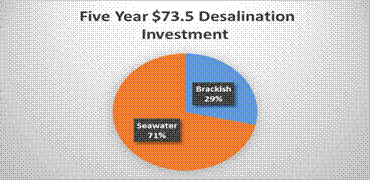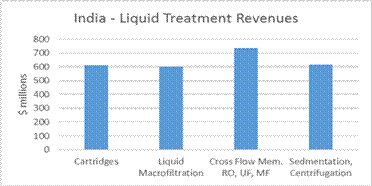
Top 50 Companies Sell 41 Percent of the Valves While 16,000 Companies Sell the
Balance
Sales of industrial valves in 2014 were $56 billion. The top 50 companies
generated revenues of $22,900 billion representing 41 percent of the total.
Market shares and sales are continuously compiled by the McIlvaine Company in
N028 Industrial Valves: World Market.
These rankings are based on the latest 12 month determinations. For public
companies, the rankings are based on the latest fiscal year report. For private
companies, the rankings are based on the year ending December 31, 2014 or for
the most current 12 months as specifically analyzed. Smaller companies are
analyzed less frequently than large ones.
The aggregate sales of the individual companies are integrated with market
forecasts by valve type, industry and geography. The total sales of
aggregated companies equal the total sales in the McIlvaine valve forecast.
So actuators and repair parts included as valve revenue by valve suppliers are
included in the market totals. On the other hand, actuators or parts sold
directly to users by third parties are not included.
The rankings are based on U.S. dollars. So American based companies
reporting sales in dollars have moved up in the rankings due to the stronger
U.S. currency.
The top five valve companies have average sales of over $1.6 billion each and
account for 15 percent of the total sales. The next five companies account
for 7 percent of the sales. Therefore, the top 10 companies have 22 percent of
the market.

![]()

Large valve companies are expanding through acquisitions and organic growth.
Purchasers are also expanding geographically and need the support of
international valve suppliers. This need is greatest for high performance
valves. McIlvaine predicts the concentration of the industrial valve
industry generally and particularly for high performance valves will continue.
For more information on
N028 Industrial Valves: World Market
click on: http://home.mcilvainecompany.com/index.php/markets/2-uncategorised/115-n028.
The Top 200 Purchasers Buy More Than 50 Percent of the World’s Water Treatment
Chemicals
The largest users of water treatment chemicals are also the industries which are
most concentrated. A few oil and gas companies produce most of the oil and
gas. Large power companies produce most of the electricity. A few
large electronics companies produce most of the semiconductors and flat panel
displays. In fact, Samsung is a leader in both products.
Due to the government ownership of wastewater plants in many countries and the
growth of third party operators such as Veolia and Suez, the water and
wastewater industry is also relatively concentrated in terms of decision makers.
Water treatment chemical producers sell directly to some large users and sell
through distributors to others. The percentage purchased by the large
users is rising and calls for more focus on this segment by the producers.
This is the conclusion reached by McIlvaine Company in N026 Water and
Wastewater Treatment Chemicals: World Market.
The 2015 treatment chemical sales will exceed $26 billion. Sales of
chemicals to provide ultrapure water (UPW) will be $1.1 billion.


The electronics and power companies dominate the market for ion-exchange resins
and other chemicals primarily used with ultrapure water. The UPW chemicals
market includes $500 million of purchases by electronics and pharmaceutical
manufacturers and $600 million by power plants. However, a few companies
dominate the electronics business and they are among the largest UPW treatment
chemicals purchasers.
|
# |
Company |
Semi |
Other Electronic |
Power |
|
1 |
Samsung |
x |
x |
|
|
2 |
Intel |
x |
|
|
|
3 |
TSMC |
x |
|
|
|
4 |
EDF |
|
|
x |
|
5 |
LGE |
|
x |
|
|
6 |
Sony |
x |
x |
|
|
7 |
SK Hynix |
x |
|
|
|
8 |
Micron |
x |
|
|
|
9 |
China
Datang |
|
|
x |
|
10 |
China
Guodian |
|
|
x |
Samsung is the largest UPW treatment chemicals purchaser followed by Intel and
TSMC. The largest power purchaser is EDF who ranks fourth.
For polymers and other chemicals used in UPW systems but also used elsewhere,
the power plants rank above the semiconductor companies. The power companies are
also large purchasers of corrosion inhibitors and anti scalants. Total
treatment chemical purchases by power plants in 2015 will be $5 billion of which
$3 billion will be spent by the coal-fired power generators.
There is subset of this group which also operates flue gas desulfurization (FGD)
systems. This process expands the treatment chemical needs. This
group is highly concentrated with just seven companies accounting for 44 percent
of the treatment purchases.
|
Water and Wastewater Treatment
Chemical Purchases
by Coal-fired Power Companies
with FGD |
|
||||||
|
# of Corp |
FGD capacity for each
MW x 1000 |
Total MW 1000 |
% of Total
Coal-fired Installed Base |
WWTC
Purchases
$ millions |
% of total
$26
billion |
Examples |
|
|
7 |
Over 50 |
575 |
44 |
1,320 |
5 |
Big 5 Chinese Corp |
|
|
10 |
10-50 |
150 |
12 |
360 |
1.4 |
AEP, TVA, Duke, Enel, EON |
|
|
15 |
5-10 |
105 |
8 |
240 |
0.9 |
NRG, Xcel, Tokyo Electric, Chubu
Electric |
|
|
20 |
3-5 |
80 |
6 |
180 |
0.7 |
AES, EPDC, RWE, CEZ |
|
|
52 |
Sub total |
910 |
70 |
2,100 |
7 |
|
|
|
350 |
0-3 |
390 |
30 |
900 |
3 |
U.S., Europe, China |
|
|
404 |
Total |
1,300 |
100 |
3,000 |
10 |
|
|
|
|
|
|
|
|
|
|
|
These seven companies will spend $1.3 billion for treatment chemicals this year.
This represents 5 percent of all treatment chemical purchases. The average
per company is 0.8 percent of total purchases. Other industries are also
concentrated. The largest 200 companies across the various purchasing industries
average more than 0.25 percent of the purchases. So in total they account for
more than 50 percent of the market.
The McIlvaine Company has created a program for suppliers to maximize sales to
the largest purchasers. It combines the treatment chemicals report
with tracking of prospects and projects.
Detailed Forecasting of Markets, Prospects and
Projects.
For more information click on:
N026
Water and Wastewater Treatment Chemicals: World Market
Other support services for the program include:
59EI Gas
Turbine and Combined Cycle Supplier Program
N049 Oil,
Gas, Shale and Refining Markets and Projects,
The new (Industrial Water Emitter) Industrial Water: Plants and Projects
http://home.mcilvainecompany.com/index.php/databases/27-water/883-n033.
Investment Plans for LNG Exceed $1 Trillion
Many areas of the world are without adequate natural gas supplies. They
can import coal but prefer gas because of its environmental advantages.
Renewables do not offer quantities of energy at reasonable cost in the near
term. Liquefied natural gas (LNG) can
supply the growing energy needs of the developing world. These needs have
resulted in plans for LNG gasification, transport and regasification investments
exceeding $1 trillion. This is the conclusion reached by the McIlvaine
Company in
N049 Oil, Gas, Shale and Refining Markets and Projects.
Over the next five years, owners will invest in new facilities generating 120
million tons per year of LNG. Investment costs will vary greatly from site
to site depending on location and process. Construction at regasification
sites (brownfields) could be as low as $500/ton of annual capacity.
Floating liquefied natural gas (FLNG) could exceed $1800/ton.
At an average of $1200/ton, annual purchases will be $29 billion and the five
year totals will be $144 billon. Equipment will represent 30 percent of the
total or $6.6 billion per year. Nearly 800 MTPA (million tons of LNG per
annum) of capacity is in the proposal stage representing investment of nearly $1
trillion.
Demand is expected to grow on an average of more than 5 percent through 2030.
U.S. projects at existing regasification plants have a competitive edge compared
to other proposed projects globally. More than 50 liquefaction projects have
been announced. Proposed capacity in the U.S. stood at 269.6 MTPA as of
the first quarter of 2015, mostly located in the Gulf of Mexico. Proposed
capacity in Canada reached 345 MTPA, including nearly 160 MTPA proposed in 2014
alone.

There are non-economic factors affecting decisions. They include security of
supply and political considerations that will impact the investments in many
regions. China is a notable example.
In November 2015, China approved a $20 billion pipeline for transporting
gasified coal from northern and western China to cities throughout the country.
It is designed to handle 30 BCM (billion cubic meters per year). The use
of gasified coal will reduce demand for LNG in China. The longer term plan
is for as much as 200 BCM. If China is able to gasify coal reliably and
economically, there would be a big negative impact on the world LNG market.

McIlvaine will continually evaluate the potential impact of the Chinese coal
gasification program and other potential impacts on the market. McIlvaine
will also adjust forecasts for filters, pumps, valves, treatment chemicals and
other products based on the LNG forecasts. This analysis is then used to analyze
the potential of projects reported daily in the program. Here is an example:
•
Petronas Selects Axens Technologies for Malaysia’s RAPID Project
•
Petroliam Nasional Berhad (PETRONAS), has selected Axens as a technology
provider for PETRONAS’ Refinery and Petrochemicals Integrated Development
(RAPID) project located in Pengerang, Johor, Malaysia. RAPID is part of
PETRONAS’ Pengerang Integrated Complex (PIC) development, which includes six
major associated facilities namely the Pengerang Co-generation Plant,
Re-gasification Terminal 2, Air Separation Unit, Raw Water Supply Project,
Liquid Bulk Terminal as well as central and shared utilities and RAPID is
estimated to cost US$16 billion while the associated facilities will involve an
investment of about US$11 billion. PIC is poised for its refinery start-up by
early 2019.
•
Regasification terminal will generate a cryogenic pump opportunity of $1
million and butterfly valve opportunity of $0.5 million. Total flow
control and treatment opportunities for the project are over $200 million.
For more information on
N049 Oil, Gas, Shale and Refining Markets and Projects,
click on:
http://home.mcilvainecompany.com/index.php/markets/28-energy/471-n049.
McIlvaine Hot Topic Hours and Recordings
McIlvaine webinars offer the opportunity to view the latest presentations and
join discussions while sitting at your desk. Hot Topic Hours cater to the end
users as well as suppliers while the Market Updates cater to the suppliers and
investors. Since McIlvaine records and provides streaming media access to
these webinars there is a treasure trove of value only a click away. McIlvaine
webinars are free to certain McIlvaine service subscribers. There is a charge
for others. Hot Topic Hours are free to owner/operators. Sponsored
webinars provide insights to particular products and services. They are
free. Recordings can be immediately viewed from the list provided below.
|
DATE |
UPCOMING HOT TOPIC HOUR |
UPCOMING MARKET UPDATES |
|
Dec. 3, 2015 |
NOx Reduction |
----------
You can register for our free McIlvaine Newsletters at:
http://home.mcilvainecompany.com/index.php?option=com_rsform&formId=5
Bob McIlvaine
President
847-784-0012 ext 112
rmcilvaine@mcilvainecompany.com
www.mcilvainecompany.com